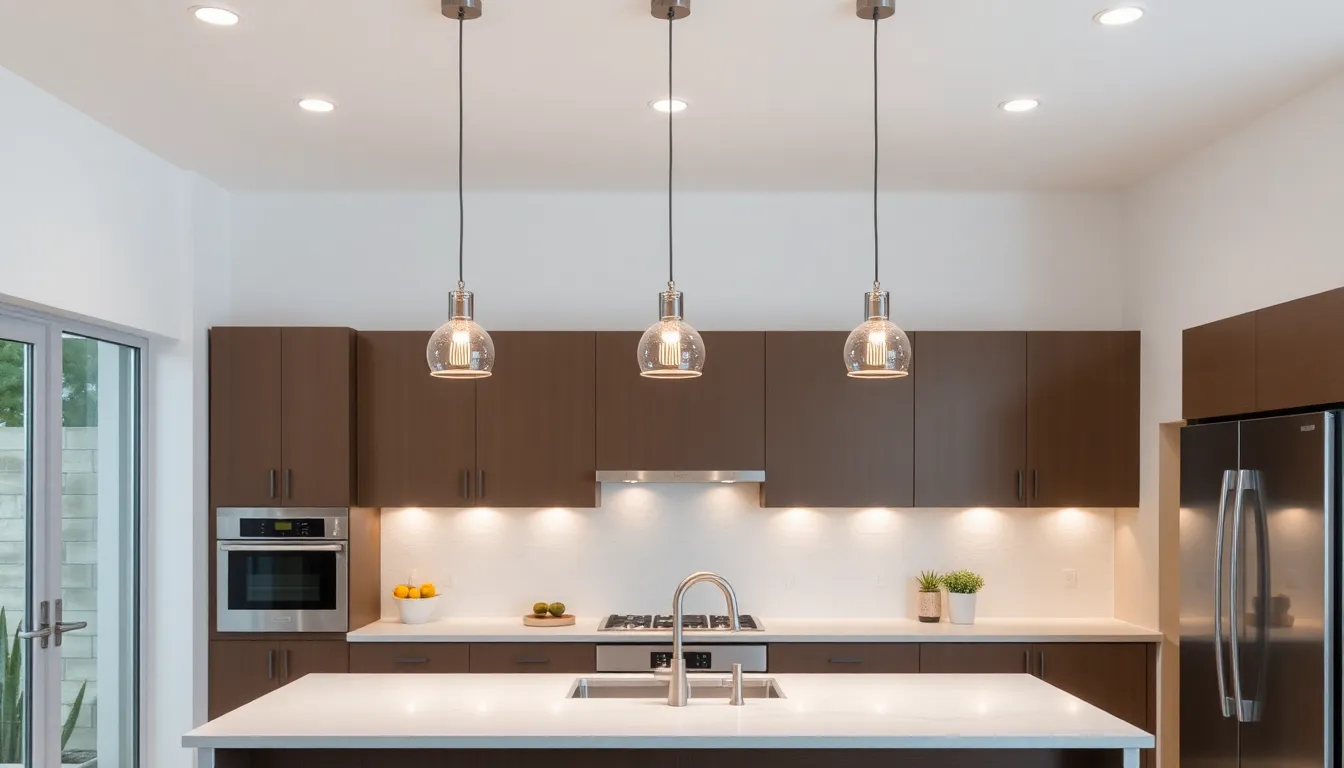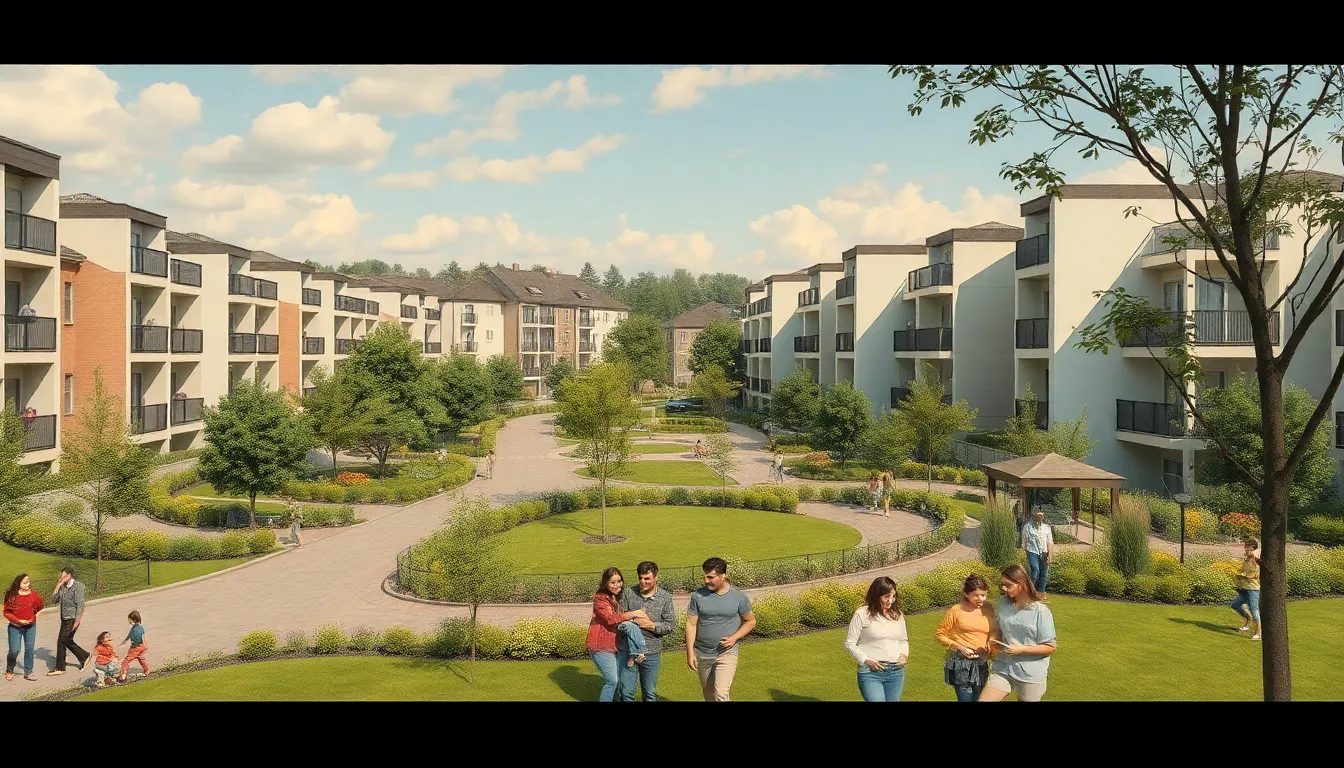Pendant lights are the unsung heroes of home decor, quietly transforming spaces from drab to fab. Imagine walking into a room where the lighting dances above your head, casting a warm glow that says, “Welcome, you’ve arrived!” These stylish fixtures don’t just illuminate; they make a statement, adding character and charm to any area.
Table of Contents
ToggleOverview of Pendant Lights
Pendant lights serve as functional and decorative fixtures in various settings. These hanging lights come in numerous styles, shapes, and materials, allowing for endless customization in design. While providing essential illumination, pendant lights also enhance the aesthetic appeal of any room.
Different pendant light designs cater to diverse needs. For instance, large, statement pieces create focal points in dining areas or living rooms. Sleek, minimalist models often complement modern decor.
Materials often influence the overall look of pendant lights. Glass options lend an elegant feel, while metal varieties offer a more industrial vibe. Wood accents can add warmth and a rustic touch to any space.
Height adjustments create flexibility in placement. For example, hanging a pendant light lower above a kitchen island promotes intimacy, while mounting it higher enhances visibility in larger spaces.
Energy efficiency plays a significant role in today’s selections. Many pendant lights incorporate LED technology, providing bright light while minimizing electricity consumption.
When selecting pendant lights, assessing the size of the room is crucial. Small fixtures suit cozy areas, while larger structures work well in expansive environments.
Overall, pendant lights combine versatility, style, and functionality, making them essential components in interior design.
Types of Pendant Lights

Various types of pendant lights cater to different design preferences and functional requirements. Understanding these options helps in making informed decisions for any space.
Mini Pendant Lights
Mini pendant lights feature compact designs that suit small areas or specific spots, such as over kitchen islands or dining tables. These fixtures often serve as accent lighting, drawing attention to visual focal points. Styles range from sleek modern silhouettes to vintage-inspired pieces, making it easy to find a match for various decor themes. Height adjustment adds versatility, ensuring proper illumination in tight spaces. Mini pendant lights, usually measuring between 10 to 15 inches in height, work well in multiples for enhanced style.
Multi-Light Pendant Fixtures
Multi-light pendant fixtures incorporate several bulbs into one design, offering striking visual appeal and ample illumination. They come in varied configurations like linear arrangements or clustered designs, catering to larger spaces needing more light. The aesthetic impact can be dramatic, turning a simple light source into a stunning centerpiece. These fixtures work effectively in dining rooms or open-concept living areas. Heights can typically be adjusted to ensure proper lighting, enhancing the overall ambiance while accommodating the specific layout of the room.
Island Pendant Lighting
Island pendant lighting targets kitchen islands or dining tables, designed to provide functional lighting that enhances workspace usability. Positioned at optimal heights, these fixtures illuminate surfaces effectively while adding style. Designs often feature multiple pendants spaced evenly, providing thorough coverage. This type creates a warm, inviting atmosphere, perfect for gatherings or casual dining. A variety of materials and finishes, including brushed nickel and glass, help achieve the desired aesthetic, melding practicality with sophisticated design.
Benefits of Using Pendant Lights
Pendant lights offer numerous advantages that enhance both functionality and aesthetics in a space. They provide targeted illumination, making them ideal for specific areas like kitchen islands, dining tables, or reading nooks. Task lighting becomes more effective with pendant lights, ensuring activities are performed with proper visibility.
A variety of styles and materials allows pendant lights to blend seamlessly with any decor theme. Whether choosing sleek metal designs for a modern look or choosing warm wooden options for a cozy atmosphere, diversity in design meets the taste of any homeowner. The ability to adjust the height gives flexibility, allowing customization to fit different room dimensions and personal preferences.
Energy efficiency becomes a significant factor when selecting pendant lights. Many designs utilize LED technology, providing bright illumination while consuming less power compared to traditional bulbs. This not only reduces energy costs but also promotes a more sustainable lifestyle.
Pendant lights also serve as decorative focal points, contributing character and charm to the overall ambiance. Unique shapes and vibrant colors can make a statement, transitioning an ordinary room into an extraordinary one. Layering lighting with pendant fixtures further enhances the depth of a room’s design.
Adding pendant lights can improve the perceived size of a room. When placed strategically, they create an illusion of height, making smaller spaces feel more expansive. This functional benefit complements their aesthetic appeal.
Finally, pendant lights support various design preferences, catering to minimalists, industrial lovers, and romantics alike. With endless options available, homeowners can find the perfect balance between style and functionality, ensuring that their lighting choices reflect personal taste while enhancing their living environment.
Design Considerations
Designing with pendant lights offers multiple layers of creativity and practicality. Careful attention to size and scale ensures these fixtures enhance rather than overwhelm a space.
Size and Scale
Choosing the right size pendant light is essential for optimal visual balance. Small pendant lights work well in compact areas like kitchens or cozy nooks. Large fixtures create impactful statements in expansive dining or living rooms. Height plays a significant role as well; hanging heights must align with ceiling types and room purposes. For instance, higher ceilings accommodate longer drop measurements while low ceilings benefit from shorter designs. Consideration of these factors helps establish harmony between the light and surrounding decor.
Style and Aesthetics
Selecting a pendant light style aligns the fixture with existing decor themes. Traditional fixtures often feature ornate designs, while contemporary models boast sleek lines and materials like brass or glass. A mix of styles can add personality, so combining various designs within a single space is feasible. Color and finish variations also impact overall aesthetics, offering opportunities to complement or contrast interior palettes. Matching the pendant light style with furniture and wall treatments creates a cohesive atmosphere, ensuring the lighting becomes an integral design element in any room.
Installation and Maintenance
Installing pendant lights requires careful planning to ensure safety and functionality. Begin by turning off the power at the circuit breaker to avoid electrical hazards. Choose the mounting location, making sure to follow the manufacturer’s instructions for specific measurements. Use a stud finder to locate support beams if the light fixture is heavy.
Connecting the wires involves stripping the ends and twisting them together securely. Match colors: black or red for hot wires, white for neutral, and green or copper for ground wires. Secure the connections with wire nuts and tuck them into the electrical box.
Maintaining pendant lights is essential for their longevity and performance. Regularly check for dust and debris accumulation on the fixture and bulbs. Cleaning with a soft, damp cloth keeps the surfaces clear, while removing bulbs allows for easier access. Use appropriate cleaners based on the material, as harsh chemicals can damage finishes.
Replacing bulbs is straightforward; ensure the fixture is off and cool before proceeding. Expected bulb life varies, but LED bulbs typically last 15,000 to 25,000 hours, significantly reducing replacement frequency. When changing bulbs, consult the fixture specifications for wattage and type to prevent damage.
Inspecting the installation periodically helps catch issues early. Look for loose connections, flickering lights, or unusual noises, signaling potential problems. Safety precautions come first; if any concerns arise, contacting a licensed electrician is the best course of action.
Following these installation and maintenance tips maximizes the benefits of pendant lights, ensuring they remain stylish and functional fixtures in any space.
Pendant lights are more than just functional fixtures; they’re essential design elements that elevate any space. With a wide range of styles and materials available, homeowners can easily find options that reflect their personal taste while enhancing the overall ambiance.
Choosing the right pendant light involves considering size, scale, and the specific needs of each room. When installed and maintained properly, these lights not only provide targeted illumination but also serve as captivating focal points that bring character to interiors.
Whether it’s a cozy nook or an expansive dining area, pendant lights offer the versatility and charm needed to create inviting atmospheres throughout the home.




